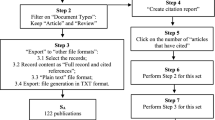Abstract
Publication and citation data are used to analyse the dynamics of the theoretical highenergy physics specialty “Monte Carlo methods in lattice field theory”. The present study is based on a comprehensive bibliography of the given subject area for the six-year period 1979–1984 and the 1979–1985 citations to these papers. The application of a recently introduced set of scientometric indicators provides clues to undertanding the growth of a new research specialty from a core body of seminal literature.
Similar content being viewed by others
References
M. J. MORAVCSIK, P. MURUGESAN, Citation patterns in scientific revolutions,Scientometrics, 1 (1979) 161–169.
D. CRANE, An exploratory study of Kuhnian paradigms in theoretical high energy physics,Social Studies of Science, 10 (1980) 23–54.
D. H. WHITE, D. SULLIVAN, Social currents in weak interactions,Physics Today, 32 (1979) 40–47.
D. H. WHITE, D. SULLIVAN, A critical review of a quantitative study of a specialty in high energy particle physics,Scientia Yugoslavica, 6 (1980) 203–212.
D. SULLIVAN, D. KOESTER, D. H. WHITE, R. KERN, Understanding rapid theoretical change in particle physics: A month by month co-citation analysis,Scientometrics, 2 (1980) 309–319.
D. KOESTER, D. SULLIVAN, D. H. WHITE, Theory selection in particle physics: A quantitative case study of the evolution of weak-electromagnetic unification theory,Social Studies of Science, 12 (1982) 73–100.
A. PICKERING, E. NADEL, Charm revisited: A quantitative analysis of the HEP literature,Social Studies of Science, 17 (1987) 87–113.
A. SCHUBERT, W. GLÄNZEL, T. BRAUN, Relative citation rate: A new indicator for measuring the impact of publications, In:Proceedings of the First National Conference with International Participation on Scientometrics and Linguistics of the Scientific Text, D. TOMOV, L. DIMITROVA (Eds), Varna, 1983, p. 80–81.
T. BRAUN, W. GLÄNZEL, A. SCHUBERT,Scientometric Indicators. A 32-Country Comparative Evaluation of Publishing Performance and Citation Impact, World Scientific Publishing Co., Singapore, 1985.
A. SCHUBERT, T. BRAUN, Relative indicators and relational charts for comparative assessment of publication output and citation impact,Scientometrics, 9 (1986) 281–291.
H.-J. CZERWON, J. VLACHÝ, Quantized Hall effect. Publication and citation follow ups of a Nobel prize discovery,Czechoslovak Journal of Physics, B36 (1986) 1101–1106.
H.-J. CZERWON, J. VLACHÝ, World publication output, research fronts and highly cited papers in the specialties of neutrino mass, neutrino oscillations and proton decay,Czechoslovak Journal of Physics, B36 (1986) 1343–1346.
H.-J. CZERWON, Monte Carlo simulations in lattice field theories — Publication output and citation impact,Czechoslovak Journal of Physics, B36 (1986) 33–38.
E. GARFIELD,Current Contents, No. 32 (1982) 5–13, No. 20 (1983) 5–16, No. 46 (1983) 5–15, No. 48 (1984) 3–14, No. 50 (1985) 3–19, No. 47 (1986) 3–17.
INIS is operated by the International Atomic Energy Agency (IAEA), Vienna, Austria, in collaboration with its Member States and co-operating international organizations;INIS Atomindex is the printed version of the data base.
High-energy physics is one of the fields in which many papers first appear in the form of reports (preprints). The extensive use of preprint services (CERN Scientific Information Service, etc.) demonstrates the importance of specific communication habits at a fixed stage of the research process. Nonetheless, we do not investigate the relevance of so-called grey literature in more detail and assume that indicators of the conventional published literature can be used as measures of scientific growth. See also M. BONITZ, P. SCHMIDT, The growing importance of R&D reports as shown by nuclear science reports,Journal of Radioanalytical Chemistry, 57 (1980) 7–16.
H. SMALL, E. GARFIELD, The geography of science: disciplinary and national mappings,Journal of Information Science, 11 (1985) 147–159.
D. de SOLLA PRICE, A general theory of bibliometric and other cumulative advantage processes,Journal of the American Society for Information Science, 27 (1976) 292–306.
E. SMITH AVERSA, Citation patterns of highly cited papers and their relationship to literature aging: A study of the working literature,Scientometrics, 7 (1985) 383–389.
J. VLACHÝ, Citation histories of scientific publications. The data sources,Scientometrics, 7 (1985) 505–528.
J. VLACHÝ, Evaluating the distribution of individual performance,Scientia Yugoslavica, 6 (1980) 155–189.
D. LINDSEY, Production and citation measures in the sociology of science: The problem of multiple authorship,Social Studies of Science, 10 (1980) 145–162.
J. R. COLE, S. COLE,Social Stratification in Science, The University of Chicago Press, Chicago, 1973.
M. L. PAO, An empirical examination of Lotka's law,Journal of the American Society for Information Science, 37 (1986) 26–33.
J. VLACHÝ, Citation analysis of world physics journals,Czechoslovak Journal of Physics, B30 (1980) 477–480.
B. C. BENNION, Estimating size and scatter of world physics journal literature,Czechoslovak Journal of Physics, B36 (1986) 19–22.
Y.-S. CHEN, F. F. LEIMKUHLER, Bradford's law: An index approach,Scientometrics, 11 (1987) 183–198.
Y. S. LIPATOV, L. V. DENISENKO, On the behaviour of information flows in multicomponent polymer systems research,Scientometrics, 9 (1986) 197–208.
Author information
Authors and Affiliations
Rights and permissions
About this article
Cite this article
Czerwon, H.J. Scientometric indicators for a specialty in theoretical high-energy physics: Monte Carlo methods in lattice field theory. Scientometrics 18, 5–20 (1990). https://doi.org/10.1007/BF02019159
Received:
Issue Date:
DOI: https://doi.org/10.1007/BF02019159




